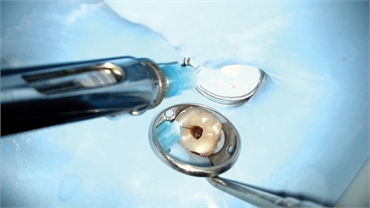Intrapulpal anesthesia
October 09, 2022



A pulp is a soft tissue structure inside the tooth that houses all the blood vessels and nerves for is normal functioning. When a tooth becomes infected or is subject to any unwanted pressure or injury, then the pulp becomes inflamed. This inflammation manifests in the form of pain. The gradual depletion of pulp leads to the tooth becoming eventually devoid of blood vessels and nerves. This leads to the infection getting spread to the adjacent tissues and bony structure.
The most common dental treatment for a tooth infection or trauma that cases harm to the pulp is the root canal treatment. In order to perform such an invasive treatment, it is important to anesthetise the concerned tooth or teeth. In order to do so, the dental surgeon opts to numb the nerves exactly adjacent to the tooth (infiltration). If the tooth is severely infected or needs to be extracted (especially in the lower jaw) , the trunk of the nerve supplying that particular side of the jaw is numbed (block).
Indications for intrapulpal anesthesia
There are times when even the combination of a block and infiltration may not be enough to anesthetise the tooth. In such cases additional methods called supplementary techniques are used. These include injecting anesthesia between the gums and tooth (intraligamentary) or within the underlying bone (intraosseous) or in the bony septum between two teeth (intraseptal). When all these techniques are I effective, then the final resort is the intrapulpal injection.
Intrapulpal injection technique
As the name suggests, intrapulpal injection involves injecting the anesthesia in the pulp space. The pulp of the tooth is accessed from within the tooth. Once the decayed portion is removed from the enamel and dentin, the pulp chamber is exposed. The needle of the syringe is positioned inside the root canal and the anesthesia is deposited. The dental surgeon will also experience some back pressure while delivering the anesthetic solution.
Advantages of intrapulpal anesthesia
The advantage of intrapulpal anesthesia is that it will begin its effect immediately. Unlike some other injection techniques, no special equipment is needed in order to opt for the intrapulpal technique. Apart from the anesthetic agent itself, the back pressure while depositing the solution compresses the nerves which also adds to the anesthetic effect.
Disadvantages
The intrapulpal technique is the only supplementary technique that involves the syringe directly touching the pulp tissue. Since this tissue is a hub for nerves and blood tissues, direct contact of the needle tip results in extreme pain for the patient. Once the intrapulpal anesthesia is delivered, the dental surgeon has only 15 minutes till the numbing effect fades away.
There are two ways in which the pain during intrapulpal injection can be reduced. One is by utilizing needles of smaller diameters. Another technique includes application of benzocaine and hyaluronic acid over the pulp before inserting the needle.
During a root canal treatment, once an intrapulpal anesthesia is administered, the next step involves removal of all pulpal tissue from the root canals and cleaning of the canals. Usually, if an intrapulpal anesthesia is not given, then sodium hypochlorite is used to remove all necrotic tissue. However, if an intrapulpal injection is given, then sodium hypochlorite should be avoided as the reaction it gets involved in with the anesthetic agent leads to the formation of xylidine, a carcinogen.
Children often present with false feedbacks after administration of anesthesia. Even the sound of the dental drill and the anxiety caused by the dental environment in general might lead to the child crying or throwing tantrums. It becomes tricky for the dentist to determine if there is any pain because of a failed anesthesia. In order to eliminate any doubt, an intrapulpal injection can be given during the procedure. Even though the child will feel pain during this technique, it will help the dentist understand that any negative behavioral changes by the child would be because of an external factor and not the definitely numbed tooth.
Hot tooth is a condition where it is difficult to achieve anesthesia. This is because of high sensitivity to pain due to the blockage of certain channels that facilitate the action of local anesthetics. In such cases, supplementary techniques like intraseptal and intrapulpal can be immensely useful.
Intrapulpal anesthesia is used as a last resort to achieve complete anesthesia of the tooth. Despite being a painful technique for the patient, it guarantees complete anesthesia for a certain period of time where the dentist can complete a major portion of the treatment. There are no adverse complications or post-operative signs experienced by the patient after receiving treatment under intrapulpal injection.

